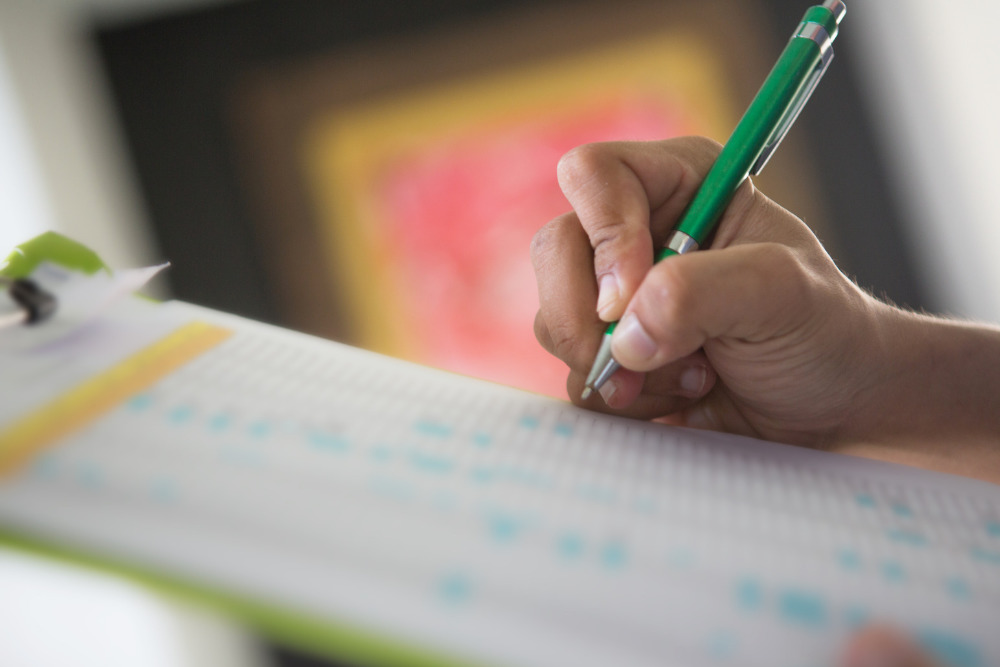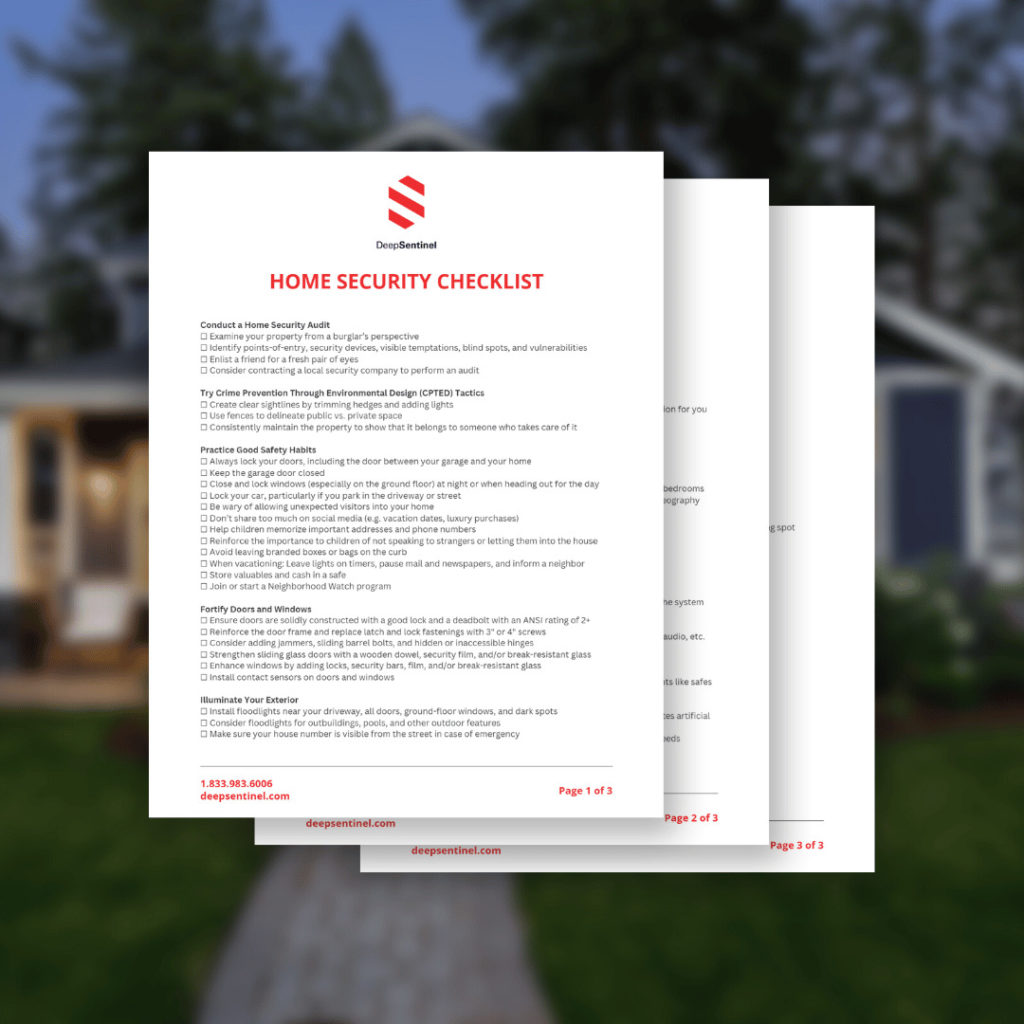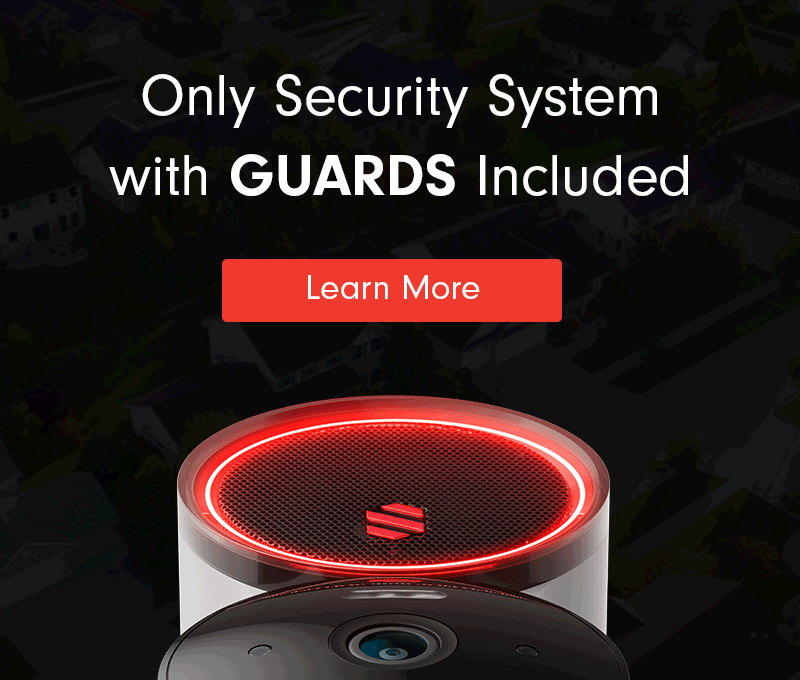The Better Home Security Checklist

Homeownership comes with a lot of expenses and responsibilities. You have to contend with your mortgage, insurance, repairs, renovations, utilities, lawn care, snow removal, HOA or condo fees, property taxes, and on and on… That’s to say nothing of external threats like theft and burglary. But it’s worth it for the serenity that comes with having your own space as a sanctuary. To ensure that your home is the safe fortress that you need it to be, get started with this home security checklist.
The Importance of Home Security
Your home is typically the largest purchase in your life, so it makes sense that you’ll want to take care of it. But are you doing everything possible to protect your investment and your family?
Consider the following:
- There were nearly 6.5 million reported property crimes in 2020, including 4.6 million thefts and over 1 million burglaries.
- Thefts resulted in $6.8 billion in total annual losses
- Burglaries resulted in $2.8 billion in losses (an average of $2,700 per incident)
- The nationwide property crime rate in 2021 was 19.3 cases per 1,000 residents.
- Property crime substantially increased in 62 of the 100 largest cities when comparing 2021 and 2022 data.
Those are big numbers and big money. So how can you decrease the odds of being targeted and increase the odds of catching the perpetrator? With a comprehensive home security checklist and action plan.
Some stats for comparison:
- Only 25% of Americans use a security system to protect their home.
- You’re 300% more likely to be targeted if you don’t have a security system.
- About 60% of convicted burglars will move on to the next property when they see security devices.
But is that all you can do? Not by a long shot.
The Better Home Security Checklist
Comprehensive home security is multi-layered. It includes devices, strategies, and behaviors that work together to safeguard your property from threats. It is both proactive and reactive. This home security checklist covers all aspects of keeping your home and your family safe.
☐ Conduct a Home Security Audit
A security audit is a thorough examination of your home and property from a security perspective. The goal is to identify all points-of-entry, blind spots, existing security devices, assets, threats, and potential weaknesses. Because you can’t fix what you don’t know is broken.
Do it yourself, or find a local security company to do it for you. If you go the DIY route, try to consider your property from a burglar’s perspective. What looks vulnerable? Are there visible temptations? Consider enlisting a friend for a fresh pair of eyes.
☐ Study the Pillars of CPTED
In the same vein, crime prevention through environmental design (CPTED) is a strategy that encourages the use of deliberate design elements to eliminate or reduce criminal behavior before it happens. CPTED also requires thinking like a burglar.
The pillars of CPTED include:
Methods recommended by the philosophy include keeping trees and hedges neatly trimmed, using fences to clearly designate public vs. private space, installing security cameras and signage, and consistently maintaining the property to demonstrate that it belongs to someone who takes care of it. Check out the International CPTED Association for more tips and tricks.
☐ Practice Good Safety Habits
Benjamin Franklin famously said that “an ounce of prevention is worth a pound of cure.” In modern words, “better safe than sorry.” The safest house in the world won’t be very safe if you neglect basic security habits.
- Always lock your doors. This includes the door between your garage and your home! Close and lock windows (especially on the ground floor) at night or when heading out for the day. And lock your car, too, particularly if you park in the driveway or street.
- Be wary of allowing unannounced individuals, like someone claiming to be from the electric or phone company, into your home.
- Don’t share too much on social media, like when you’ll be on vacation or a luxury purchase. After all, 78% of would-be burglars use these platforms to gather intel on potential targets.
- Help your children memorize your home address as well as the phone numbers of a few trusted adults. Reinforce the importance of not speaking to strangers or letting them into the house.
- Avoid leaving branded boxes or bags on the curb. You don’t need burglars to know about that new TV or laptop you just bought.
- When you leave your home for an extended period, consider leaving lights on to make it look like someone is home. Or better yet, invest in automatic timers. Likewise, be sure to pause mail and newspapers when you go on vacation. And inform a trusted neighbor that you’ll be away so they can keep an eye on your place.
- A safe for valuables and cash is always a good investment.
- Join or start a Neighborhood Watch program.
You may not need to take all of these steps, but you’ll regret it if something happens because you didn’t.
☐ Fortify Doors and Windows
Most burglars enter through a door or window. Locking them is a good deterrent, but it may only slow a determined thief down for a few minutes.
A good door has a solid core of wood, metal, or fiberglass, a high-quality lock, and a deadbolt with an ANSI rating of at least 2. A fortified door goes beyond that with a reinforced frame, additional measures on the inside like jammers or sliding barrel bolts, and hidden or inaccessible hinges. (If you’d like more details about how to secure your door from being kicked in, we have a guide for that, too.)
Strengthen sliding glass doors with at least a wooden dowel to prevent them from being opened. There are plenty of glass door security options you can try for extra protection, like security film or break-resistant glass.
Likewise, burglar-proof windows should have a decent lock on them at a minimum. You may also need to install window security bars, film, or security glass. The level of window fortification you choose depends on where the windows are located within your home, your comfort level, and the safety of your neighborhood.
And don’t forget about making your garage more secure! Keep it closed. Lock the door to the house. (Yes, this tip was already listed above, but it bears repeating.)
Install contact sensors on doors and windows. Cheap, simple, and effective, these trigger an alarm and instantly notify you of any unauthorized access. That way, you get at least a short head start if there’s trouble. Just don’t forget to activate the system at the proper time of day.
☐ Illuminate Your Exterior
Burglars love the dark. So take it away from them. Lighting increases the risk of being seen or caught. Adequate illumination will make your property less appealing than another without it.
Always-on or motion-activated floodlights are a low-tech way to secure your property. Install security lights at or near your front and back doors, side windows, and any other dark spot or corner.
☐ Use Motion Detectors
Install motion detectors both inside and out. How do motion sensors work to make your home more secure? They can integrate with floodlights, cameras, sirens, and more. Once activated, any movement will trigger it.
Some even have settings and technology to differentiate between a potential intruder and a benign trigger like your toddler or pet. This is important for cutting down on the number of false alarms, which are a major limitation of these devices.
☐ Consider Getting a Dog
Not only are they man’s best friend, but dogs can be a powerful burglar deterrent for some (though not all) would-be criminals. At the very least, most will bark when a stranger attempts to get in. With ample training, your pooch could be a “bone-a-fide” watchdog. Some breeds are more suited to the task, though. So if you’re looking for a canine protector, be sure to research the best guard dog breeds.
☐ Combat Other Threats
Protecting your home doesn’t mean just against people. You need to guard your household against natural threats, too.
Your property absolutely must have functional, up-to-date smoke and carbon monoxide detectors. Change the batteries and test your detectors every 6-12 months. When your current detectors expire after a few years, install replacements. Keep a fire extinguisher handy and store escape ladders in second-story bedrooms.
You may also want to include some combination of temperature, humidity, water (for leaks and floods), and freeze sensors, too. Choose whatever fits into your budget and makes sense for your climate and geography.
It’s never a bad idea to stockpile some supplies like batteries, flashlights, bottled water, bandages, and the like. This is especially important if you live in an area that’s prone to natural disasters or extreme weather.
☐ Get a Security Alarm System (Maybe)
Generally paired with another device of some sort, such as a door/window sensor, motion detector, or camera, security alarms make a deafening noise that brings unwanted attention to the intruder. Simple but effective.
Most systems also contact a monitoring center or your local police. Knowing someone else is watching your property can provide a sense of comfort.
However, these systems are far from foolproof, and you shouldn’t rely on them as your only protection. False alarms are common, which can be annoying at best and dangerous at worst. Many cities charge fines for these nuisance alarms and won’t require a police response to the alarm call unless the crime is verified. In other words, when a burglar is actually there, the police assume it’s another false alarm and might not come quickly… or at all.
What causes these false alarms? Everything from low system batteries to rustling leaves. To minimize the issue, make sure to install and operate your system properly and clear away obstacles.
☐ Install Home Security Cameras
Home security cameras are your best deterrent and protection, inside and outside of your home. Whether always on and recording, motion-activated, or live streaming, cameras put eyes on your property every moment of every day. They give crooks a reason to look elsewhere and also provide invaluable evidence for the authorities in the event of a break-in.
Cameras come in a wide variety of types, sizes, and models, so do some research and find what works best for you and your needs. The best will include night vision, a loud siren, and 2-way audio. You’ll want a security camera resolution of at least 1080p to capture high-definition footage. You’ll also need to decide between wired vs. wireless security cameras.
Wondering where to place your security cameras? Aim to cover your doors, ground-floor windows, and high-traffic areas inside if possible. A video doorbell is a simple low-cost option to watch comings and goings and to prevent package theft. If your budget allows, also consider aiming cameras at your driveway, any outbuildings, and any rooms with high-risk contents like a safe.
It’s also important to consider who’s doing the watching. The great debate is monitored vs. unmonitored cameras. From least secure to most secure, your options are self-monitoring, passive monitoring, or active monitoring systems. Choose the best your budget allows.
🗹 Simplify with Deep Sentinel
You could certainly use a mixed bag of the devices on this home security checklist to provide layered protection. Or, you could simplify everything with smart security cameras that provide the functionality of several devices in one neat package.
Deep Sentinel offers top-of-the-line home security cameras with active monitoring by both AI and live security guards. In 30 seconds or less, LiveSentinel guards can investigate, engage via 2-way audio, and trigger a siren. A simple “can I help you?” is often enough to stop a crime before it happens. If the criminal proceeds, a guard notifies the authorities of the verified crime in progress. False alarms are a thing of the past. Fast police response is the new reality with Deep Sentinel.
☐ Consider Other “Nice-To-Have” Items
Of course, this home security checklist is only the beginning. There are seemingly endless ways to make your home more secure. Depending on your budget and your needs, you might also consider:
- Redundant power sources for all security devices
- A dedicated, encrypted Wi-Fi connection for any devices that require internet
- Fences and lockable gates around your yard
- A lock box for hiding a spare key (instead of putting it under the welcome mat) or a friendly neighbor who can hold onto a copy
- Smart locks that you can control remotely
- Thorny bushes near first-floor windows
- Prominent, clearly visible house number so emergency vehicles can find your home
- Bolt cutter-proof locks for bikes, sheds, and other equipment
- A licensed firearm unloaded and locked inside a safe or secure box
- An inventory of all belongings along with paperwork and photos in case you need to make an insurance claim
- Fire- and waterproof storage boxes for important documents
- Signs or decals saying your home is protected by cameras
- An emergency escape plan for every room of the house, including a designated meeting spot
- Personal safety devices like alarms, mace, and whistles in an easy-to-access location
Download the full Home Security Checklist below

Download the full Home Security Checklist below
Stay Safe at Home
Even if you can’t tackle every item on this home security checklist right away, a few preventative measures are better than nothing. Start with the most basic steps and invest in more robust protection as you’re able. Ensuring your home and your family are safe is worth every penny.
Need a Solution that Prevents Crime?
Deep Sentinel is the only security technology that delivers the experience of a personal guard on every customer’s home and business. Visit deepsentinel.com or call 833-983-6006

